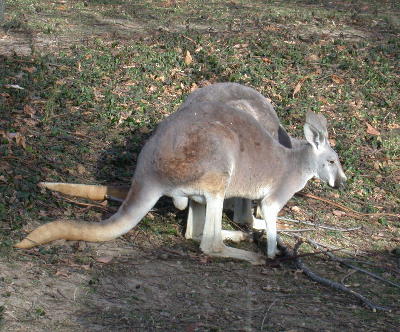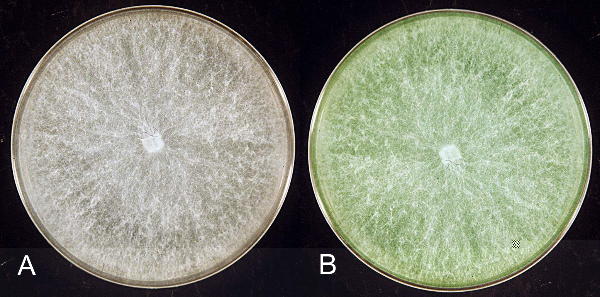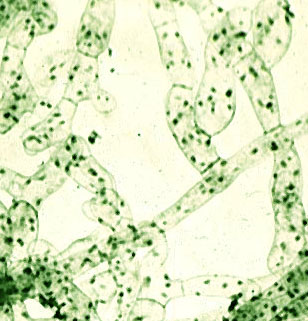

You've been hoodwinked!
You shouldn't believe everything you read on the internet!!! I've gotten email from all over the world about this web page on the fake fungus Profollias downhoki. I've had even more reports from friends of people who were hoodwinked. Three of my graduate students were fooled-- one even emailed his father about the "amazing discovery." My students know me well enough that they should have known better. One of my other grad students told them of their folly. Several of the professors in my department were skeptical as well. Apparently this fungus was fodder for some biological chat rooms, bulletin boards, and blogs. One middle school science teacher put up a page about the fungus/plant as the discovery of the month. One undergraduate student even put up a YouTube video here, with her eventual retraction here. I kind of hate to give up these interesting emails, but it's easy enough to find out that Profollias is not a real fungus online now. Here's the annotated version of the page:
Profollias downhoki---- the missing link between fungi and plants
Tom Volk's Fungus of the Month for April 2008
Please click
TomVolkFungi.net for the rest of Tom Volk's pages on fungi
This fungus was discovered in early 2008 by Gholan Faux Besides his surname meaning "fake" in French, his whole name is an anagram for "Fungal Hoax.", a noted Australian scientist at the University of New South Wales.Someone wrote and told me they couldn't find his name on the NSW university website... While looking in the pouches of kangaroos at the mechanism of attachment of the joeys (baby kangaroos) to their mothers, he noted a white mycelium growing all through the pouch. There are certainly many kinds of microorganisms growing in such a warm, moist environment, but no one had ever noticed a fungus growing so prolifically in the pouch of a kangaroo previously. Naturally the first thing they did was to try to culture the fungus so that they could study it better in the lab.
When Dr. Faux started looking at more kangaroos, he noticed that some of them had a little green areas around their pouches. From these kangaroos, he isolated the same fungus! Fulfilling the last part of Koch's postulates Apparently the fungus can grow on the skin and hair of the kangaroo, but also photosynthesize at the same time. It has never been observed to produce spores, so it is unclear how it is spread from kangaroo to kangaroo.
I hope you enjoyed learning about Profollias downhoki, the missing link fungus, with characters of both fungi and plants. I hope maybe to someday get to see a culture of this organism. It's very cool!
Updated April 1, 2008. Too subtle?
I hope you enjoyed my fun fungus of the month. If you got fooled, you're not the only one.
Learn more about fungi! Go to Tom Volk's Fungi Home Page --TomVolkFungi.net This month's fungus is Profollias downhoki, Anagram for "April Fool's Hoodwink" a recently discovered organism that is the missing link between fungi and plants. It is probably not surprising that this organism was found in Australia, being the home of hundreds of kinds of weird animals, plants and fungi. Many scientists go to Australia to study the wide range of strange creatures. It seems like people will believe just about anything biologically from Australia, home of the platypus and the kangaroo.
This month's fungus is Profollias downhoki, Anagram for "April Fool's Hoodwink" a recently discovered organism that is the missing link between fungi and plants. It is probably not surprising that this organism was found in Australia, being the home of hundreds of kinds of weird animals, plants and fungi. Many scientists go to Australia to study the wide range of strange creatures. It seems like people will believe just about anything biologically from Australia, home of the platypus and the kangaroo.
 When Dr. Faux and his lab associates tried to culture the fungus on standard lab media it failed to grow. So, considering the natural habitat of the fungus, they had to make a new kind of medium. They eventually cultured the fungus on kangaroo dextrose agar (KDA) Although it would be fun to make, I can't imagine what this medium would be like. I suppose you'd have to strain the hair and bones out. I did actually make *chicken soup agar* once for my thesis., where it grew quite well. However, they found a curious anomaly. When they grew the culture in the dark, it was a typical looking white mycelium. However, when they grew it in direct sunlight, it was green! Some of you correctly pointed out that both images are the same, but one is rotated 180 degrees and colored in Photoshop. Well if you've ever grown cultures of fungi you know that sometimes green conidia, the asexual reproductive structures of the fungus, form on the plate. This is what Dr. Faux assumed, but he told his graduate student, Gus BonSuguf, Anagram for "Bogus Fungus." to take a look at the fungus to see if he could identify it. What Gus found, however. was shocking. There were no conidia, but the mycelium itself had turned green. Very strange!
When Dr. Faux and his lab associates tried to culture the fungus on standard lab media it failed to grow. So, considering the natural habitat of the fungus, they had to make a new kind of medium. They eventually cultured the fungus on kangaroo dextrose agar (KDA) Although it would be fun to make, I can't imagine what this medium would be like. I suppose you'd have to strain the hair and bones out. I did actually make *chicken soup agar* once for my thesis., where it grew quite well. However, they found a curious anomaly. When they grew the culture in the dark, it was a typical looking white mycelium. However, when they grew it in direct sunlight, it was green! Some of you correctly pointed out that both images are the same, but one is rotated 180 degrees and colored in Photoshop. Well if you've ever grown cultures of fungi you know that sometimes green conidia, the asexual reproductive structures of the fungus, form on the plate. This is what Dr. Faux assumed, but he told his graduate student, Gus BonSuguf, Anagram for "Bogus Fungus." to take a look at the fungus to see if he could identify it. What Gus found, however. was shocking. There were no conidia, but the mycelium itself had turned green. Very strange!
 When Gus showed Dr. Faux the fungus under the microscope on high power, they noticed the green structures you see to the left. These hyphae have chloroplasts!! These are actually nuclei in the hyphae of Morchella, colored green in Photoshop Shocking! Well. Dr. Faux was certainly excited, but he did not believe the results without some molecular biology. Molecular biology will solve all our biological problems, right? When they sequenced the fke region of the DNA of the chloroplasts from the hyphae, they found that it exactly matched the fke =Fake region of the DNA of the chloroplasts of mosses and green algae, indicating a common origin. However the DNA of the nuclei of the fungus indicated that the fungus belonged to the same taxonomic group as the dermatophytes, like Epidermophyton floccosum, which cause diseases such as athlete's foot and ringworm. This seemed to add a touch of authenticity, leading some to believe that Profollias might also be a dermatophyte.
When Gus showed Dr. Faux the fungus under the microscope on high power, they noticed the green structures you see to the left. These hyphae have chloroplasts!! These are actually nuclei in the hyphae of Morchella, colored green in Photoshop Shocking! Well. Dr. Faux was certainly excited, but he did not believe the results without some molecular biology. Molecular biology will solve all our biological problems, right? When they sequenced the fke region of the DNA of the chloroplasts from the hyphae, they found that it exactly matched the fke =Fake region of the DNA of the chloroplasts of mosses and green algae, indicating a common origin. However the DNA of the nuclei of the fungus indicated that the fungus belonged to the same taxonomic group as the dermatophytes, like Epidermophyton floccosum, which cause diseases such as athlete's foot and ringworm. This seemed to add a touch of authenticity, leading some to believe that Profollias might also be a dermatophyte.
Of course there came the dilemma of what to call this new species. Dr. Faux decided to call it Profollias downhoki. Pro means before and follias refers to leaves, so Profollias means "before leaves," an appropriate name for a primitive plant. Makes it more believable to say it in Latin, doesn't it? The epithet downhoki refers to an aboriginal name for this particular type of kangaroo, the Downhok, named in turn for its type of fur. Yeh I made this part up.
If you have anything to add, or if you have corrections, comments, or recommendations for future FotM's (or maybe you'd like to be co-author of a FotM?), please write to me at

This page and other pages are © Copyright 2008 by Thomas J.
Volk, University of Wisconsin-La Crosse.